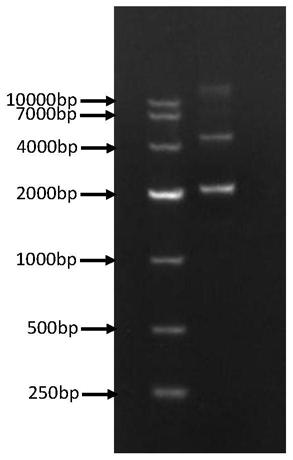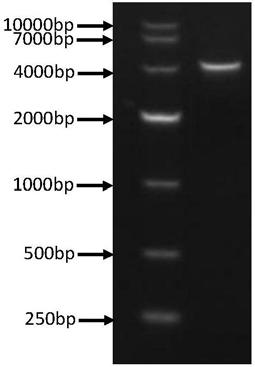DNA standard sample for transgenic component detection and application of DNA standard sample
A technology for genetically modified components and standard samples, which is applied in recombinant DNA technology, DNA/RNA fragments, and microorganism determination/inspection, etc., which can solve problems such as increasing the workload of testing, pushing up testing costs, and inconvenient testing.
- Summary
- Abstract
- Description
- Claims
- Application Information
AI Technical Summary
Problems solved by technology
Method used
Image
Examples
Embodiment 1
[0068] Example 1. Construction of plasmid standard samples
[0069] 1. Determination of ten kinds of foreign gene sequences
[0070] According to a large number of market research data, first determine all the truly commercialized genetically modified lines on the market, and then determine the following seven screening elements as the screening elements that cover the corn DAS40278, soybean DP305423 and soybean CV127 lines: T-E9, T- NOS, P-35S, PAT, T-PinII, P-Rbcs4, T-35S; Finally, we inquire and determine the line-specific sequences of three transgenic lines: corn DAS40278, soybean DP305423 and soybean CV127.
[0071] Through a large number of transgenic information retrieval, sequence comparison, sequence splicing and sequence stability analysis and prediction, the potential sequence complementarity problem between different foreign genes is solved, so that all foreign sequences in the final recombinant plasmid can achieve stable expansion. Finally, the 7 selection elements and ...
Embodiment 2
[0085] Example 2. Preparation of standard samples of standard plasmid molecule pUC57-Exo
[0086] 1. Extraction of plasmid DNA
[0087] The positive strains of the pUC57-Exo plasmid were drawn on a plate to pick out monoclonal colonies, and cultured with shaking at 37°C for 16-18h in 1ml of LB broth containing antibiotics. Aspirate 100μL of culture solution to 100mL of antibiotic-containing LB culture solution for expansion, culture with shaking at 37°C for 16-18h (OD value above 0.8), and collect a total of 100mL bacterial solution. Centrifuge at 6000g for 15 min at 4°C to collect the bacteria. The QIAfilter Plasmid Midi Kits was used for mass extraction and purification of plasmid molecules.
[0088] 2. Plasmid DNA quality evaluation and concentration determination
[0089] Take 1 μL of the extracted plasmid DNA sample and use 1% agarose gel electrophoresis to detect it. If the band is clear and bright, it indicates that the quality of the extracted plasmid DNA is good. See elect...
Embodiment 3
[0123] Example 3. Homogeneity detection of standard samples
[0124] 1. Number of samples
[0125] Fifteen tubes were randomly selected from the candidate standard samples packed into the smallest packaging unit in step 6 of Example 2 for uniformity testing.
[0126] 2. Using fluorescence quantitative PCR method for uniformity detection
[0127] Fluorescent quantitative PCR was performed on 10 exogenous elements. The primers and probes used are shown in Table 4. The working principle of fluorescent quantitative PCR is: Taq DNA polymerase in PCR reaction has 5'→3' exonuclease Active, it can hydrolyze the hybridization probe labeled with fluorescent pigment to release the reporter group and produce fluorescence. The intensity of the fluorescent signal emitted by the reporter group is proportional to the exponentially increasing target DNA fragment. By detecting the fluorescent signal, the PCR products of each reaction stage can be monitored in real time. PCR amplification of 10 kinds ...
PUM
 Login to View More
Login to View More Abstract
Description
Claims
Application Information
 Login to View More
Login to View More - R&D
- Intellectual Property
- Life Sciences
- Materials
- Tech Scout
- Unparalleled Data Quality
- Higher Quality Content
- 60% Fewer Hallucinations
Browse by: Latest US Patents, China's latest patents, Technical Efficacy Thesaurus, Application Domain, Technology Topic, Popular Technical Reports.
© 2025 PatSnap. All rights reserved.Legal|Privacy policy|Modern Slavery Act Transparency Statement|Sitemap|About US| Contact US: help@patsnap.com



